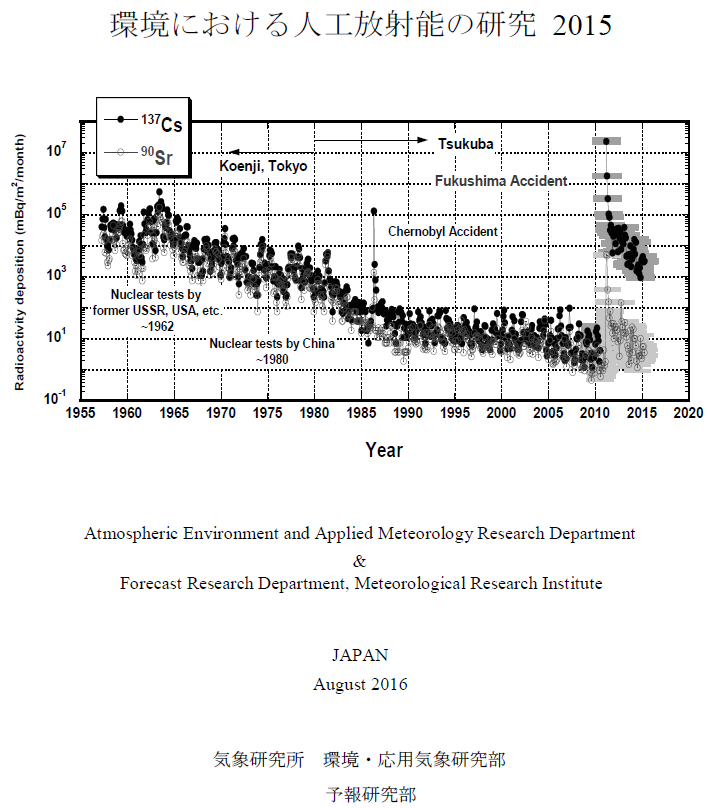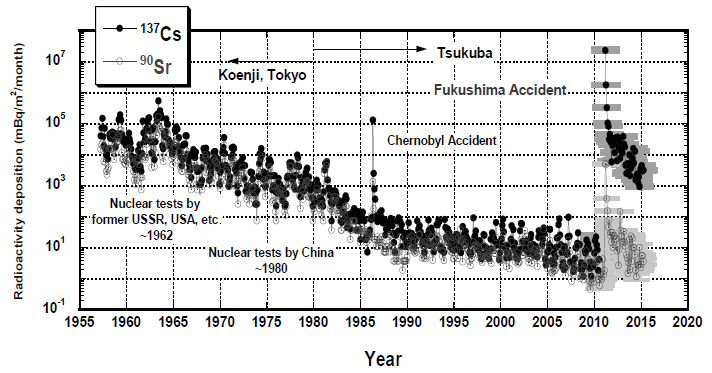

表紙の図説明
2015年8月までの90Srおよび137Cs月間降下量
福島第一原発事故後の大気の放射能汚染の実態把握を継続しています。2011年3月の事故以降に確定できた90Srおよび137Cs月間降下量を対数軸で誤差と併せてプロットしています。
134Csは事故直後には137Csとほぼ等量降下していますから、放射性セシウム全体ではこのプロットのほぼ倍量となります。
ただし、90Sr、137Csはどちらもおよそ30年の半減期で減衰しますが、134Csはおよそ2年で半減します。図示した誤差は計測の統計誤差で、1シグマです。測定誤差は本来全ての測定値につき表示すべきですが、グラフが見づらくなるため、従来はあえて表示してきませんでした。また、数十年前のデータについては誤差データが伝えられていません。
福島第一原発事故以前に採取され、分析や前処理途上だった試料については、事故の汚染によって実験室環境および測定室環境、測定機器のバックグラウンドなどが大幅に上昇したため、蒸発濃縮工程においても試料の汚染(コンタミネーションと言います)の問題が発生します。そのため、観測値を求めること自体が困難になっていましたが、試料を汚染の水準の低い関西にて分析しこの問題の回避に努めました。しかし、本文中にあるように、細心の注意と努力にもかかわらず、2010年の後半および2011年初のデータは欠測となってしまいました。
徐々に実験環境の除染や測定機器の入れ替えなどを実施して事故以前のきれいな実験環境を追求し、データを求めるように努めています。また、IAEAが実施した分析相互比較に参画するなどし、その精度の維持管理に努めていますので、現状のデータの信頼性は担保できていると考えています。
A caption of the cover art
Monthly depositions of 90Sr and 137Cs before August 2015.
We have been monitoring the deposition amounts for the purpose of understanding the actual condition of radioactive pollution after the accident of Fukushima Daiichi Nuclear Power Plant (FDNPP). The
monthly deposition amounts of both 90Sr and 137Cs, which were successfully fixed values after the accident in March 2011, are shown in logarithmic axis with error widths. Since the deposition amounts of
134Cs were nearly equal to those of 137Cs, the total amounts of radioactive cesium were approximately two times of the values in this figure. We would like to note that the half-lives of 90Sr and 137Cs are
approximately 30 years, however, 134Cs decays to half in about 2 years. The error widths are one sigma in statistical error of measurements. Although the error widths of all measurement values were better to be
shown, error values used to be not shown on purpose to avoid busy figure in the former versions. In addition, error data before several decades are not handed down.
For the analysis of samples collected before the accident of FDNPP and not measured then, significant increase of background values were severe problem, because environments including laboratories and
instruments were polluted, and it was also problem that samples could have been polluted in the operations of concentration or other preprocesses (contamination problem). We overcame the difficulty by
carrying the analysis out in western Japan (Kansai area) where the pollution level was low, however, the data during the latter part of 2010 and the former part of 2011 were lacked in spite of our efforts as
described in the main text.
We are making efforts to recover clean working environment as before the accident, by cleaning of the environments, exchanging instruments, etc. for the purpose of acquire the correct data. In addition, we
maintain the precision of the data, for example, by participating inter-comparison programs performed by IAEA, so that, the credibility of the data are assured (please refer to the section: quality control of
radioactive analysis of atmospheric deposition samples ).
Note on COPYRIGHT
Permission to use any scientific material (text as well as figures) in this homepage of the Geochemical Res. Dep./MRI should be obtained from the authors.